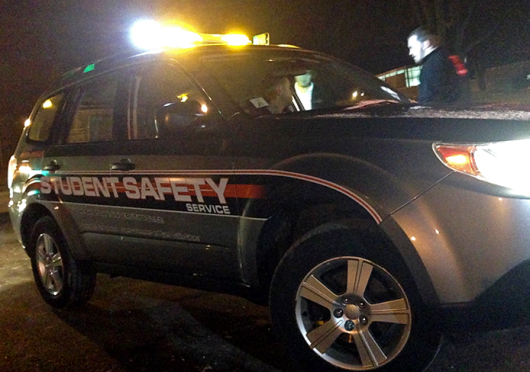
Operation Safeguard, which began as a pilot program for the Department of Public Safety in September, allows student officers from Student Safety Service to conduct high-visibility nightly patrols in neighborhoods east of High Street. Credit: Eric Weitz / Lantern reporter
As part of a university initiative to increase security near off-campus student housing, Student Safety Service has extended its high-visibility patrols east of North High Street for another semester.
Operation Safeguard, which began as a pilot program for the Department of Public Safety in September, allows student officers from Student Safety Service to conduct high-visibility nightly patrols in neighborhoods east of High Street every day with extended hours on Friday and Saturday.
“We are trying to make the area saturated with security presence so that anybody who would seek to do a crime would think otherwise,” said Student Safety Service program coordinator Sean Bolender. “It’s more about deterrence than anything.”
Dan Hedman, spokesman for the Office of Administration and Planning, said so far, the program has yielded some promising results.
“Over the past few months, we have seen a slight decrease in incidents of crime in the immediate off campus area when compared to the same time last year,” Hedman said in an email. “However, as this is a pilot program, it is important to note we cannot say for certain what has impacted this decrease.”
Neal Wilson, Student Safety Service senior manager and a recent Ohio State graduate, said the program continues to change as officers work through the pilot phase.
“It is still a very dynamic program in the sense that we haven’t hammered out all the details yet or all of our policies on it,” he said. “We don’t have anything concrete written into our standard operating procedure at this time.”
Wilson said the changing nature of the program is what makes the initiative interesting.
“We, as current Student Safety officers, get to actually assist in figuring what’s going on and actually get feedback for it,” he said.
Wilson said feedback provided by current student officers allowed the program to expand the perimeter of off-campus areas that officers could patrol.
Operation Safeguard is intended to go beyond students noticing the student officers during patrols, as it is also designed to increase interaction between students and officers.
Wilson said students notice the officers on patrol and talk to them, sharing security-related information.
“I can say from personal experience there have been times when people will come up and report things to us while we are sitting there or while we are driving around,” he said.
While the patrols are meant to be a crime deterrent, officers are trained to provide first aid and are able to report criminal activity to police as needed, Wilson said.
As part of Operation Safeguard, Student Safety Service officers also station their mobile command center near the south end of the Ohio Union, giving students the opportunity to talk with officers.
Hedman said officers interact with an average of 33 students each night as part of Operation Safeguard.
Since Operation Safeguard was launched, 15 Student Safety Service officers have been hired to the program, which now employs about 35 student officers.
All of the student officers are trained in and assigned to other Student Safety Service programs in addition to Operation Safeguard.
Hedman said the 15 additional positions were funded by the Office of Administration and Planning.
Officials will continue to monitor the progress of the pilot program throughout the semester, Hedman said.
“We want to make sure that if we are going to be spending university resources, we are doing it wisely,” Bolender said. “If we don’t think this is a return on our investment, we need to look to make changes, but we won’t know if that is the case until we have gone through a full academic year to really evaluate it and to see how it performs.”
Hedman said Operation Safeguard is part of a larger initiative aimed at reducing crime near the High Street corridor that also includes a joint patrol and joint jurisdiction initiative between University Police and the Columbus Division of Police.


